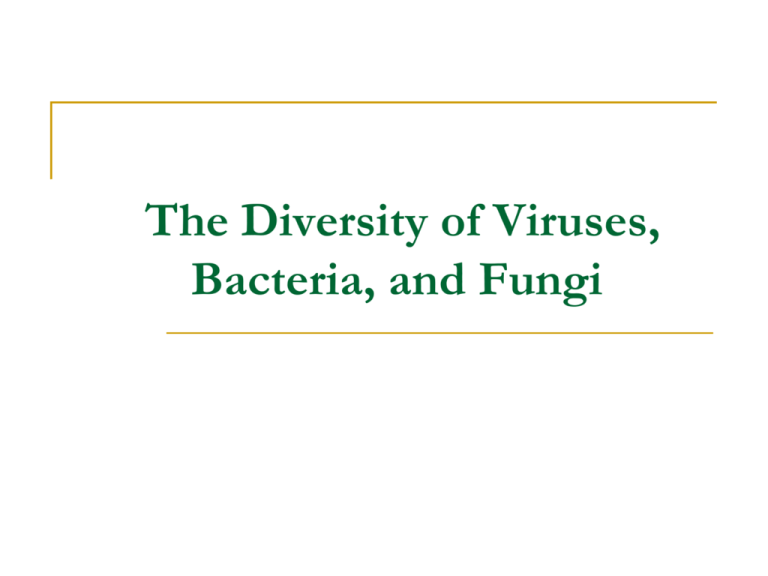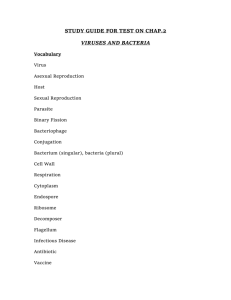
The Diversity of Viruses,
Bacteria, and Fungi
1 µm
Staphylococcus
cyanobacterium
Escherichia coli
Eukaryotic cells
(10–100 µm)
Prokaryotic cells
(0.2–10 µm)
Viruses
(0.05–0.2 µm)
Viruses
Defining Characteristics
A virus is a noncellular infectious agent.
Viruses are major pathogens and infect
virtually all living organisms from animals to
bacteria.
The two defining characteristics of a viruses
are:
A viral particle consists of a protein coat wrapped
around a nucleic acid core (the Genome).
A virus CANNOT reproduce itself. Its
reproduction is dependent upon the host cell.
glycoproteins
envelope
(lipid bilayer)
protein
coat
spikes
core
proteins
genetic material
(viral RNA)
coated with protein
reverse
transcriptase
viral RNA
protein
subunits
of coat
polyhedral virus
helical virus
DNA
protein coat
complex virus
sheath
base plate
tail fiber
rabies virus
herpes virus
bacteriophage
measles virus
Copyright © 2005 Pearson Prentice Hall, Inc.
tobacco
mosaic
plant virus
Ebola virus particles
Treating Viral Infections
Because viruses use the host cell machinery
in order to reproduce, the illnesses that they
cause are difficult to treat.
Viruses also have high mutation rates, which
makes it inevitable that when a population of
viruses is being treated with an antiviral drug,
a mutation will arise that will result in
resistance to the drug.
Prokaryotes (Bacteria)
Characteristics of Prokaryotes
Prokaryotes are microscopic (too small to be
seen without a microscope)
Most abundant organisms on earth.
Metabolically diverse
Do not contain membrane bound nuclei or
organelles
Usually have a single chromosome
Most contain a cell wall
Reproduce by fission
Come in three basic morphologies
Prokaryotic Cell Morphology
coccus
bacillus
spirillum
The Prokaryotic Cell
DNA
capsule
bacterial flagellum
pilus
plasma
membrane
cell wall
ribosomes in
cytoplasm
cytoplasm
The Cell Wall
A semi-rigid structure that helps the cell maintain its
shape and resist rupturing.
Composed of peptidoglycan molecules
The cell wall is often enclosed by a glycocalyx or a
sticky mesh composed of polypeptides,
polysaccharides, or both. It helps the cell attach to
surfaces such as teeth and mucous membranes and
protect against phagocytosis.
When highly organized and firmly attached it forms a
capsule
When less organized and loosely attached it forms a slime
layer.
Endospores
When some rod-shaped bacteria encounter
inhospitable conditions, they form protective
structures called Endospores.
An Endospore forms inside of a bacterium
and contains genetic material and a few
enzymes encased within a thick protective
coat.
Endospores are resistant to extreme
environmental conditions.
endospore
bacterium
Two Kinds of Prokaryotes
Archaebacteria – the bacteria that live under
extreme conditions. Divided into 3 categories
Extreme Halophiles – live in high salt
environments
Methanogens – Produce methane gas and live in
oxygen free environments such as the gut and
swamps
Extreme Thermophiles – live in extremely high
temperatures (> 80°C).
Eubacteria – the most common bacteria.
Can be divided into two sub-groups:
Gram-positive
Gram-negative
The Gram Stain
A staining technique called the Gram stain is
commonly used in identification of bacterial
species.
Expose to a purple dye and then iodine
Wash with alcohol
Counterstain
Gram-positive cells stain purple
Gram-negative cells stain pink
Bacillus subtilis
Gram positive
E. coli
Gram negative
Eubacteria
Photoautotrophs – Cyanobacteria: aerobic
cells that engage in photosynthesis. Some
convert nitrogen gas to ammonia for use in
biosynthesis.
Chemoautotrophs – derive energy by
combining oxygen with inorganic molecules
such as sulfur, ammonia, and nitrite.
Chemoheterotrophs – derive energy by
breaking down organic compounds .
Prokaryotic Growth and Reproduction
Growth is measured by the increase in the
number of cells in a population.
Under ideal conditions cell division can occur
in as little 10 to 30 minutes in some bacteria
and as long as 15 hours in other bacteria.
Prokaryotic cells reproduce by a mechanism
called Fission.
bacterial
chromosome
Bacterium before
DNA replication
DNA replication
begins
parent DNA
molecule
DNA copy
DNA replication
completed
Membrane growth
moves DNA
molecules apart
New membrane and
cell-wall material
deposited
Cytoplasm
divided in two
Bacteria and Human Health: Good
Bacteria
Some bacteria are beneficial to other
organisms
Lactobacillus used to make pickles, yogurt,
sauerkraut, and buttermilk.
Actinomyces used as a source of antibiotics
Various bacterial components are used in
vaccines
Escherichia coli makes vitamin K and compounds
that help us digest milk.
Bad Bacteria:
Pathogens
Pathogens are bacteria or parasites that threaten
our health and well-being.
They synthesize toxins that cause disease
symptoms.
Some E. coli strains cause diarrhea
Clostridium botulinum causes botulism, C. tetani causes
tetanus
Borrelia burgdorferi causes Lyme disease
Streptococcus variants cause pneumonia and strep throat.
Treponema pallidum – syphilis
Neisseria gonorrhoeae - gonorrhea
Fungi
Fungi
Fungi obtain their nutrients from other
organisms.
Fungi propagate by spores.
Most fungi can reproduce both sexually and
asexually.
Fungi and Us
Fungi attack plants that are important to
people.
Fungi cause human diseases.
Fungi can produce toxins.
Many antibiotics are derived from fungi.
Fungi make important contributions to gastronomy.
Wine and beer are made using yeasts
Yeasts make bread rise
Research details of both….
•
Firm cell walls (generally of “chitin”)
•
“Spores” as reproductive bodies
•
Unique chromosomes and nuclei
•
Includes molds, yeasts, rusts, and
mushrooms
hyphae - the vegetative bodies of most fungi, constructed
of tiny filaments
mycelium -an interwoven mat of hyphae
Human hair
Fungal hypha










